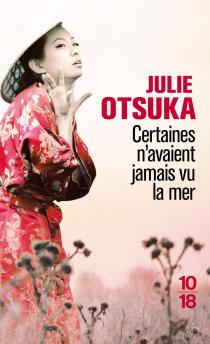
Voici un roman qui a beaucoup fait parler de lui. Comme toujous, je suis méfiante envers tout ce qui a trop de succès, mais lorsque j'ai trouvé ce roman m'attendant bien sagement sur l'étal de mon libraire, je l'ai pris avec moi.
I heard a lot about this novel, and as I am always a bit hesitant when it comes to stuff that are " fashionable ", it took me time to read it.
Résumé - Synopsis
On suit le destin de jeunes femmes japonnaises, qui s'en vont épouser des hommes partis faire fortune aux USA. Elles ne les connaissent qu'en photo. Traversant l'Océan Pacifique en bateau, elles déchantent vite lorsqu'elles commencent leur nouvelles vies d'épouses japonaises en Amérique. Nuit de noce, vie de couple, enfantement, travail, ségrégation, misère, déportation, oubli... la vie de ces femmes, sacrifiées, est célébrée.
The reader follows the destiny of Japanese women, who travel all the way to the USA to marry Japanese men who moved there to seek a better life. They only thing they know about each other is what they look like on the photo they got of their prospective spouse. Crossing the Pacific Ocean, they quickly realise that their dream life is... just a dream. Wedding night, married life, birth, work, segregation, misery, deportation, and at last, being forgotten... the untold story of these sacrificed women is, at last told and celebrated.
Mon avis - Review
La spécificité de ce roman tient à son mode narratif original: le " protagoniste " est multiple. On parle de " roman choral ", ce qui résume bien la situation. Chaque chapitre est dédié à une phase de la vie de ces jeunes femmes qui s'en vont à l'aventure, vivre une nouvelle vie.
The way the novel is narrated is very specific: the " main character " isn't one person, it's a group, and individuals don't really matter (we don't follow the story of a specific group of people, let's say X, Y and Z. We follow the story of the group " Japanese women "). Each chapter is dedicated to a phase of the life of these young women who go on an adventure, looking for a better life.
Le premier chapitre est dédié au voyage en bateau, et l'on apprend que " certaines n'avaient jamais vu la mer ". Puis viendra la rencontre avec ce mari tant fantasmé. Pour certaines, ce sera l'amour, pour d'autres une vie de compagnonage, et pour d'autres encore une vie d'escalve domestique. La maternité, le travail dans les champs (les japonais étaient un peu les mexicains d'alors, se tapant tout le travail manuel, et les femmes étant " bonnes " en ville). Les enfants grandissent et essaient de se contruire une identité nippo-américaine.

The first chapter is about the boat trip, and we learn that " some had never ever seen the sea before " (That's the French title, btw). Then they meet their prospective husband. For some, it will be love at the first sight; for others, a lifetime companionship; and for some unfortunate women, they'll become a domestic slave. Maternity, working in the fields (Japanese people were like the Mexicans of that time, " second class citizens " working the fields, and the women were often domestic workers at the home of rich White women). Kids grow up, and try to find an identity as Japanese-Americans. They're a new kind of people.
Et puis, la guerre. La ségrégation. Les arrestations. Le pire dans tout ça? Cette page de l'histoire américaine, complètement occultée.
And then, WW2 broke. Japan unfortunately sided with Germany, which means that Japanese people living in the US became suspicious. Segregation, jail... And do you what's worse? This dark episode of American history has been conveniently " forgotten ".
La guerre donc, et Pearl Harbor. Les japonais et les américains se livrent une guerre sans merci dans le Pacifique. Et qui est-ce qui trinque? Les immigrants japonais aux USA, installés là depuis des dizaines d'années, et qui n'ont rien demandé. Mais forcément, ils sont suspects. Forcément, ils sont de mèche avec leurs compatriotes restés au pays. Un peu comme " tous les arabes " après les attaques du World Trade Center. A croire que l'on n'apprend strictement rien du passé. Hier les japonais étaient tous des terroristes, aujourd'hui les arabes. Bref.
So, WW2, and Pearl Harbour happens. Japan and the USA are fighting in the Pacific. And who pays for this? The Japanese migrants in the US, settled there since decades, in peace. But they suddenly become very suspicious. They are " the enemy ". A bit like " the Arabs " after the World Trade Center attacks. It seems that we never, ever learn. Yesterday, every Japanese was a terrorist, today every Arab is one. Oh my...
Pour être sur et certain que ces " sales jap " ne sabottent pas le pays, les gouvernement américain construit d'immenses camps de concentration dans le désert, pour mettre les japonais " en sécurité ". Certains en reviendront, d'autres pas.
To make sure that Japanese migrants don't pose a threat to the country, the US government builds massive concentration camps in the desert, where entire Japanese families are put for " their own security ". Yeah, right. Some will never come back.
Le dernier chapitre du roman est poignant. Il a pour thème l'oubli. Les riches femmes qui ont un instant de conscience et se demandent ce qui a bien pu arriver à leur " si gentille " bonne japonaise, et puis qui la remplacent par une chinoise. Les enfants qui oublient leurs camarades de classe japonais. La vie qui suit son cours, sans eux... comme de l'eau qui se referme sur un souvenir. Comme s'ils n'avaient jamais existé.
The very last chapter of the book is very moving. The theme is " being forgotten ". The rich white women, who wonder what happened to their " oh so nice " Japanese maid, and who quickly replace her by a Chinese one. The children who forget their Japanese classmates. Life goes on, but without them... as if they had never ever existed.
Un roman déroutant, donc, de par sa forme, et dérangeant en ce qu'il nous force à nous mettre face à notre humanité. C'est très court, ça se lit en une heure maximum, et ça fait cogiter.
It is a very short, but strong book. The way it's narrated is a very uncommon, but powerfull: It's like a chorus of women, and we hear all their voices. You'll read it in one hour, and you'll think about it for days.
Traduction - Translation
Le titre originel est The Buddha in the Attic, qui peut être traduit littéralement par " Le Bouddha dans le Grenier ". Ce titre donne une perspective différente au roman: comment la culture japonaise est cachée, mais toujours pratiquée. Comment s'intégrer sans perdre ses racines.
The French translation is Some had never seen the sea, which is one of the first sentence of the book. Quite different from the original title of The Buddha in the Attic, which is more about how Japanese had to adapt to America.
La traduction française reprend une phrase du début du roman, lorsque les filles embarquent ves leur nouvelle vie: certaines n'avaient jamais vu la mer. On se concentre plus sur l'aspect " aventure ", " nouvelle vie ", et " roman choral ".
The French title is more about the " chorus of women " (as most sentences begin with " some ": " some had never seen the sea ", " some were happily married ", etc..).
Couverture - Art
Les versions en anglais montrent toutes une ombrelle japonaise: une jeune femme en kimono tenant une ombrelle sur son épaule, une ombrelle dépliée, et enfin, celle qui me parle le plus: une ombrelle dans une valise.
All the art covers of the book in English show a Japanese umbrella: a young woman in a kimono with an umbrella on her shoulder, an open umbrella, and an unbrella in a suitcase (that's my favourite).
Les version française et russe montrent une jeune femme asiatique en kimono. Là où la version française évoque lassitude et romantisme, la version russe évoque plutôt la détermination.
The French and Russian version both show a young Asian woman wearing a kimono. The French version is evocative of tiredness and romanticism, while the Russian version shows a very determined young woman.
Enfin, la version japonaise se démarque de toutes les autres avec un décors végétal et fleuri, et je dois dire que je ne vois pas trop le rapport avec l'histoire.
The Japanese version, weirdly, shows a field a flowers. I don't really see how it is connected to the story though.
L'auteure-the author
(de Goodreads et Wikipedia) Julie Otsuka est née en 1962 à Palo Alto, en Californie. Son père était ingénieur aérospatial, et sa mère travaillait en tant que technicienne de laboratoire avant de donner naissance à Otsuka. Ses deux parents sont d'ascendance japonaise. A l'âge de neuf ans, sa famille a déménagé à Palos Verdes, en Californie. Julie Otsuka a deux frères.
(from Goodread and Wikipedia) Julie Otsuka was born in 1962, in Palo Alto, California. Her father worked as an aerospace engineer, while her mother worked as a lab technician before she gave birth to Otsuka. Both of her parents were of Japanese descent. At the age of nine, her family moved to Palos Verdes, California. She has two brothers.
Après avoir étudié l'art à l'Université de Yale, Julie Otsuka a exercé en tant que peintre pendant plusieurs années, avant de se tourner vers l'écriture à l'âge de 30 ans.
After studying art as an undergraduate at Yale University she pursued a career as a painter for several years before turning to fiction writing at age 30. She received her MFA from Columbia. She is a recipient of a Guggenheim Fellowship, the Asian American Literary Award, and the American Library Association Alex Award.
Produits dérivés - Byproducts
En France, le livre a été adapté en pièce de théatre.
Videos
En anglais sous-titré français (English with French subtitles):
In English (anglais seulement):

